Wild parsnip (original) (raw)
Wild parsnip (Pastinaca sativa) is an invasive plant native to Europe and Asia. It was likely brought to North America by European settlers, who grew it for its edible root. Since its introduction, wild parsnip has escaped from cultivated gardens and spread across the continent.
Wild parsnip, which is also known as poison parsnip, is a member of the carrot/parsley family. It typically grows a low, spindly rosette of leaves in the first year while the root develops. In the second year it flowers on a tall stalk and then dies. The plant can form dense stands and spreads quickly in disturbed areas such as abandoned yards, waste dumps, meadows, open fields, roadsides and railway embankments. Its seeds are easily dispersed by wind and water, and on mowing or other equipment.
Like giant hogweed and other members of the carrot family, it produces sap containing chemicals that can cause human skin to react to sunlight, resulting in intense burns, rashes or blisters.
Range
In North America, scattered wild parsnip populations are found from British Columbia to California, and from Ontario to Florida. It has been reported in all provinces and territories of Canada except Nunavut. The plant is currently found throughout eastern and southern Ontario, and researchers believe it is spreading from east to west across the province.
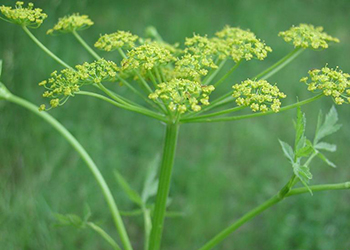
Flowers grow in yellowish-green clusters. Photo: Leslie J. Mehrhoff, University of Connecticut, Center for Invasive Species & Ecosystem Health
Impacts of wild parsnip
- The plant can form dense stands that outcompete native plants, reducing biodiversity.
- Stem, leaves, and flowers contain chemicals that can increase skin sensitivity to sunlight and cause severe dermatitis.
- Wild parsnip reduces the quality and saleability of agricultural forage crops such as hay, oats, and alfalfa.
- Chemical compounds in the plant are known to reduce weight gain and fertility in livestock that eat it.
How to identify wild parsnip
- Grows up to 1.5 metres tall.
- The single green stem is two to five centimetres thick and smooth with few hairs.
- Compound leaves are arranged in pairs, with sharply toothed leaflets that are shaped like a mitten.
- Yellowish green flowers form umbrella-shaped clusters 10 to 20 centimetres across.
- Seeds are flat and round.
Check the information below to know how to identify wild parsnip.
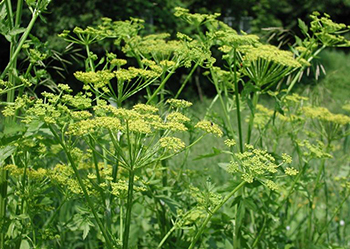
Wild Parsnip has umbrella shaped flower clusters. Photo: Leslie J. Mehrhoff, University of Connecticut, Bugwood.org
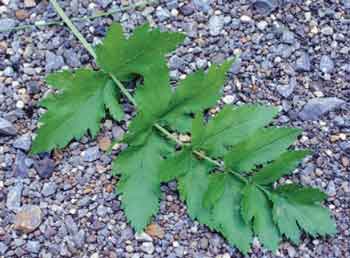
Wild parsnip leaf. Photo: Ohio State Weed Lab Archive, The Ohio State University, Center for Invasive Species & Ecosystem Health
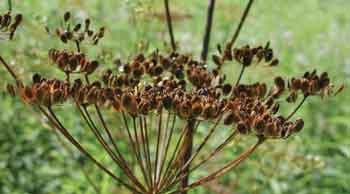
Wild parsnip’s umbrella-shaped flower clusters form round, flat brown seeds. Photo: Leslie J. Mehrhoff, University of Connecticut, Center for Invasive Species & Ecosystem Health
Similar Species
There are several plants that look similar to Wild parsnip such as Giant hogweed, Cow parsnip, Purplestem angelica, and Queen Anne’s-Lace (also known as Wild carrot).
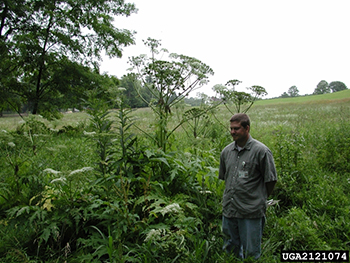
Giant Hogweed (Heracleum mantegazzianum) Photo: Thomas B. Denholm, New Jersey Department of Agriculture, Bugwood.org
- Species: Giant Hogweed. (Heracleum mantegazzianum)
- Height: 2.5 to 5 m
- Flowers: Large, white umbrella- shaped flower clusters 30 to 90 cm across, made up of 50 to 150 small flower clusters
- Leaves:
- Prominently spiked edges
- Up to 1.5 m long
- Leaflets grow right out of each side of main stem, with no leaf stalk
- Stem:
- Hollow, 5 to 15 cm thick
- Prominent purple blotches
- Distinct, coarse, bristly hairs
- Lifecycle: Biennial (lives for 2 years) or perennial (lives longer than 2 years)
- Origin: Invasive
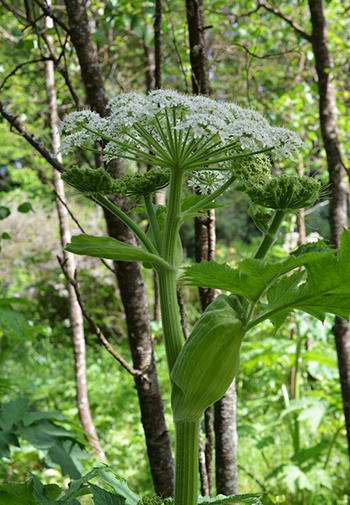
Cow Parsnip. Photo: Shaun Winterton, Aquarium and Pond Plants of the World, Edition 3, USDA APHIS PPQ, Bugwood.org
- Species: Cow Parsnip (Heracleum maximum)
- Height: 1 to 2.5 m
- Flowers: White umbrella- shaped flower cluster 10 to 30 cm across, made up of 15 to 30 small clusters
- Leaves:
- Leaves have lobes shaped like a hand with fingers, with fuzzy undersides
- Up to 0.5 m long and wide Leaf blade separated from main stem by leaf stalk
- Stem:
- Hollow, 5 cm thick at base
- Green, few to no purple spots Soft and fuzzy hairs
- Lifecycle: Perennial
- Origin: Native
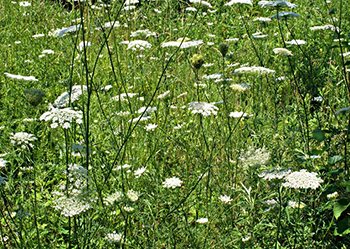
Queen Anne’s Lace. Photo: Ansel Oommen, Bugwood.org
- Species: Queen Anne’s Lace (Daucus carota)
- Height: 0.3 to 1.5 m
- Flowers:
- White flower cluster 5 to 10 cm across. Pale pink before fully opened.
- Often single purple flower in centre of flower cluster
- Leaves:
- Leaves are staggered along the stem (alternate)
- Leaves consist of leaflets that are finely divided into narrow segments.
- Each segment of the lower leaves is further divided into fine lobes, resulting in a feathery appearance
- Stem:
- Green, 1 to 2.5 cm thick
- Covered with fine bristly hairs
- Lifecycle: Biennial
- Origin: Invasive
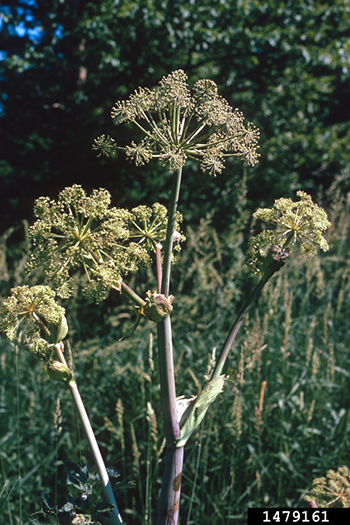
Angelica. Photo: Alex Katovich, Bugwood.org
- Species: Angelica, Angelica spp.
- Height: 1.2 to 2.1 m
- Flowers: Greenish-white globe-like flower clusters 8 to 25 cm across
- Leaves: Alternate leaves, divided into 2 to 3 leaflets
- Stem:
- Purple or purple blotched
- Smooth (no hairs)
- Lifecycle: Perennial
- Origin: Native
Wild parsnip removal and management
If you have small clusters of wild parsnip on your property (fewer than 100 plants), you may be able to manage the plant yourself. Wear protective clothing and dispose of plants carefully, as described below. To remove larger infestations (thousands of plants), you will likely need a professional exterminator and repeated treatments over several years.
Note: To manage wild parsnip effectively, learn how to identify the plant in both its first-year stage as a small rosette of leaves, and in its second year, as a tall flowering plant.
The area must be monitored for several seasons to ensure complete eradication.
Protective clothing
Wear protective clothing, including waterproof gloves, long- sleeved shirts, pants and eye protection. A disposable spray suit over your normal clothing provides the best protection. Spray suits are commercial-grade waterproof coveralls.
After working around the plant, remove your protective clothing carefully to avoid transferring any sap from your clothing onto your skin. Wash your rubber gloves with soap and water, then take off your spray suit or outer clothing.
Wash your rubber gloves again and then take them off. Finally, take off your protective eye wear. Put non-disposable clothing in the laundry and wash yourself immediately with soap and water.
Mechanical control
For a small infestation in a yard or garden (fewer than 100 plants), dig out as much of the taproot as you can with a sharp shovel or spade. Digging is most effective in the spring when the soil is moist and the taproot is more easily removed. Follow-up digging will be required every few weeks to deal with re-growth (if the taproot was not completely removed) or missed plants.
Pulling up the plants is impractical for larger infestations, but mowing can be effective if begun just after peak blooming, but before the seeds set in the late summer or early fall. Cut plants will likely re-sprout after mowing, so it is important to combine mowing with other control methods.
Another method of control is to cover the dug or mowed areas with black plastic to smother new growth of all plants. The plastic should be left in place for at least one season to ensure the roots are smothered. The area must be replanted after the plastic is removed to replace desirable plants and rehabilitate the soil.
Chemical control
In Ontario, herbicide use, storage and disposal is regulated under the Pesticides Act. While many uses of herbicides are banned, certain herbicides may be used to control plants that are poisonous to humans who touch them, such as wild parsnip. Herbicides that may be used for this purpose include those containing the active ingredient glyphosate.
If you are considering using a pesticide, read the product label before buying it to ensure it can legally be used on wild parsnip.
Herbicides containing glyphosate can be an effective tool to control larger populations of wild parsnip. Glyphosate is a broad spectrum herbicide that kills green plants that it comes into contact with. New seedlings will often germinate and emerge after glyphosate has been applied, meaning that follow up applications may be required.
For the best results, apply herbicide to the leaves of actively growing plants in the spring, followed by a summer application for missed plants that are still growing. Herbicide treatments may need to be repeated in following years. Follow directions on the product label and provincial and federal laws when using herbicides.
Disposal
Do not burn or compost wild parsnip plants that have been cut down or dug up. If possible, leave the stems to dry out completely at the site. Carefully dispose of plant material in black plastic bags and leave in direct sun for a week or more. Contact your municipality to determine if the bagged plants can be sent to your local landfill site.
What you can do
- Learn how to identify wild parsnip and other invasive plants.
- Stay on trails and away from areas known to have wild parsnip or other invasive species.
- Inspect, clean and remove mud, seeds and plant parts from clothing, pets (including horses), vehicles (including bicycles) and equipment such as mowers and tools. Before travelling to new areas, clean vehicles and equipment in a place where plant seeds or parts aren’t likely to spread, such as in a driveway or at a car wash. It’s very important to carefully wash any sap from clothing, equipment and pets.
- Avoid disturbing soil and removing plants from natural areas; they may be rare native plants or even invasive plants.